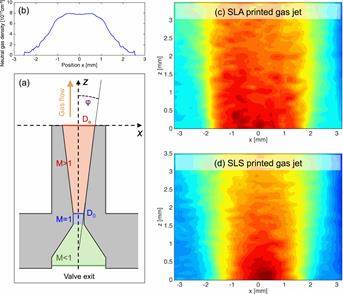Andreas Döpp’s results published in Review of Scientific Instruments
Results of Andreas’ work performed with the LOA team led by Prof. Victor Malka have been published as 3D printing of gas jet nozzles for laser-plasma accelerators in the Review of Scientific Instruments journal.
Recent results on laser wakefield acceleration in tailored plasma channels have underlined the importance of controlling the density profile of the gas target. In particular, it was reported that the appropriate density tailoring can result in improved injection, acceleration, and collimation of laser-accelerated electron beams. To achieve such profiles, innovative target designs are required. For this purpose, the authors have reviewed the usage of additive layer manufacturing, commonly known as 3D printing, in order to produce gas jet nozzles. Notably they have compared the performance of two industry standard techniques, namely, selective laser sintering (SLS) and stereolithography (SLA). Furthermore they have used the common fused deposition modeling to reproduce basic gas jet designs and used SLA and SLS for more sophisticated nozzle designs. The nozzles are characterized interferometrically and used for electron acceleration experiments with the Salle Jaune terawatt laser at Laboratoire d’Optique Appliquée.

(a)
(a) Schematic design of a supersonic de Laval nozzle. Main parameters are the inner diameter D0 and the exit diameter De, the Mach number M and the opening angle φ. (b) Interferometrically measured density profiles at z = 0.3 mm for a FDM printed jet. (c) and (d) show density profile maps ne(x, z) for SLA and SLS printed nozzles, respectively.
Full article:
'3D printing of gas jet nozzles for laser-plasma accelerators', A. Döpp, E. Guillaume, C. Thaury, J. Gautier, K. Ta Phuoc and V. Malka, Rev. Sci. Instrum. 87, 073505 (2016). http://dx.doi.org/10.1063/1.4958649